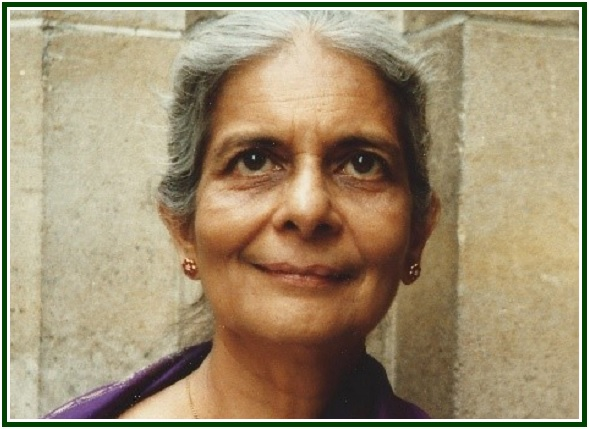
Nurturing Violence in Any Area Has Effects on
Every Aspect of the World and Human Society
Radha Burnier

Ms. Radha Burnier
What anyone regards as lunacy or madness depends on what that person perceives as reality. In the framework of a particular reality, certain kinds of thought and action are believed to be sane. To people with a different experience of reality, those thoughts and actions may seem mad.
The neurotic’s visions appear unreal and abnormal to everybody who does not share his internal experience. And of course, while attaching the label ‘mad’, ‘neurotic’, and so on what the majority of people experience is taken to be proven fact. Therefore, not only the neurotic and the psychologically deranged, but all who are more sensitive and able to respond to finer vibrations are dubbed crazy. Those who can testify to the reality of finer planes of existence are so few that their words either carry no weight, or they are all held to be demented.
The word ‘madness’ is sometimes defined in dictionaries as irrationality, presumably of an extreme kind, there being an element of irrationality in almost everyone who is supposed to be sane. But when connections within the mind between one thing and another are too tenuous, the irrationality produces tangible effects and gets classified as abnormality or madness.
As indicated above, the accepted pattern of behaviour is ‘normality’, and behaviour that conspicuously fails to conform to the pattern is suspect. So the genius, the bold reformer and the non-conformist could be and many times are ‘mad’ in the eyes of the mediocre. The word ‘madness’ is relative.
Much has been said recently about the mad-cow’s disease, caused by feeding animals on offal and other unnatural substances. The strange behaviour of the cows is induced by the artificial feed, and then people who eat the flesh of these poor creatures also show symptoms of crazy behaviour. ‘Madness’ here is a byproduct of the clever dealings of profit-hungry human beings.
Unfortunately, if a sufficient number of people behave in an atrociously irrational manner, because they represent the ‘norm’, their irrationality is no longer identified as ‘madness’. Numbers make the ‘irrational’ and the unrealistic attitudes ‘normal’. As an example we can cite war-mindedness. Talks have been going on for decades about banning nuclear weapons, ever since Einstein and Bertrand Russell asked the question: ‘Shall we put an end to the human race, or shall mankind renounce war?’
During all this time, miraculously, wholesale destruction has not rained down on earth. On several different occasions the temptation to start a nuclear war was very great but it did not happen. Hence the world in general chooses not to take note that there is an ominous problem. Everybody is in a state of hypnotic indifference, or satisfied in their belief that a policy of deterrence will avert the ultimate disaster. Deterrence means tit for tat, having as much power as others, or more. So the arms race goes on, nuclear tests poison air and earth, and all nations are vying with each other to get the best of the bargain.
Knowing that the more weapons humanity has, the nearer it is to self-destruction, if people go on believing in weapons as the source of their well-being, what sanity is there? The talk about reducing nuclear weapons is always irrational and contradictory, because all nations want to retain a position of power.
Those who stand absolutely for peace, wanting to renounce not only nuclear power, but war-making in any form, with nuclear, chemical, biological, laser, psychological or other means – the wholly committed pacifists in the present-day world – are ‘cranks’. They may be put in jail in an emergency, because they are the only sane people. The absolute faith in peace arising from the experience of a different kind of reality – the reality of an unbreakable commonality of origin, destiny and interest – is held to be impractical, contemptible or punishable according to expediency.
Violence is Madness
Even those who are against war do not necessarily see the insanity of violence in other forms, because it belongs to the contemporary ethos. Indiscriminate sale of weapons, along with the technological knowledge at the disposal of vast numbers, puts power in the hands of the masses, without their having the good sense to know how to use it. This is aggravated by the cultivation of violence through television and other media, the lauding of brutal sports such as hunting and boxing, and encouragement to ruthless competition.
In a shocking description of ‘a nation entertaining itself into barbarism’, George F. Will quotes the remarks of onlookers enjoying a boxing match: ‘His tooth went flying out of the ring’, ‘He is going to snap his arm – he did it too!’, and so forth.
Six States in the USA, we are told, permit such spectacles, where faces are pounded to pulp, and the flow of blood exhilarates the stupid spectators. The justification is that the contest is between consenting adults. In the crowd, there are even children, brought along, one might think, in order to ensure a future for violence.
There are other countries of the world where ‘consenting adults’ chop off the hands or heads of delinquents, also providing ‘entertainment’ to a crowd of men, women and children. Terrorists, audiences at these shows, and millions of adults and children engaged in systematic and cruel handling of animals are part of a culture which deadens the mind until it is utterly unable to see facts.
A report in The Washington Post on the abuse of orphaned children in China is indicative of what is gradually becoming commonplace. The photograph shows a child tied to a chair, legs astride, with a basin underneath. This is hardly different, to eyes accustomed to brutality, from keeping animals clamped down by steel for the convenience of the commercial interests. Only a little reasoning power is needed to realize that nurturing violence in any area will result in enormous repercussions on the world in general and on every aspect of human society. Are people who coldly convert pigs into bags of flesh so heavy that they cannot stand on their own feet mad or sane? It is taken for granted that they are sane because gene-transfer technology is commonly used now. The truth is that a cruel, violence-prone mind is more dangerous than nuclear, biological or other weapons. Those who cannot see this fact may pretend that they are sane, but they are part of a culture bent upon turning the world mad.
Shadow and Light
The pleasing and the not-pleasing are so interwoven that they are indeed like opposite sides of a coin. It is pleasant to lie down in bed after a day’s work, but not for too long; the pleasure becomes pain if it is overdone. Every enjoyment comes to a point where it induces weariness and boredom. Moderation seems to be called for by the way the opposites work.
It is a kind of springtime here at Adyar. The Banyans, the Mahoganies and the fragrant Neems are bursting with new life; the tender green of the leaves is enchanting. This is also the time when many other trees are in bloom. The great silk-cotton tree, with large red flowers high above against the blue sky, is a wonderful sight; all over India and at Adyar too, we can see it flowering in this season. Carpets of yellow flowers have been spread out by the many Peltophorums, commonly known as Copper Pod trees. The indigenous Asoka, which has been glorified in many Indian paintings, is covered with yellow flowers (Saraca typengensia), or a profusion of red flowers (Saraca indica). We have been delighting in both. Several other glorious sights greet human eyes, and attract birds. But all this happens while the sun proceeds northwards in order to usher in the hot weather. The heat of summer is the other side of the delight that the season brings.
Some people tend to be more conscious of the pleasant and good in the varied situations of life, and are happy. Others concentrate on the not-pleasing and are discontented. Do we see the glass as half full or half empty? Manifestation is the play of opposites. The play is maya. In the Everlasting there are no opposites, there is only supreme good.
000
Radha Burnier (1923-2013) was the international president of the Adyar Theosophical Society between 1980 and 2013.
The above article was published in the associated websites on 16 November 2020, being reproduced from “The Theosophist”, Adyar, Chennai, India, April 1996 edition, pp. 243-245, “On the Watch-Tower”. It can also be found at the October 2019 edition of “The Aquarian Theosophist”, pages 8-11.
000

Helena Blavatsky (photo) wrote these words: “Deserve, then desire”.
000